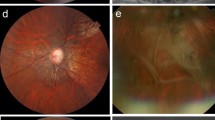Abstract
Three cases of congenital stationary night blindness are reported. In all patients a negative electroretinogram was recorded by single bright flash stimulation and changed to positive on sequential reduction of the stimulus intensities. Oscillatory potentials were recognized. Biphasic dark adaptation curves and moderate elevation of the relative logarithmic final threshold of dark adaptation were also found. Values of critical flicker fusion frequency were reduced to a mild or moderate extent. VEP latency was prolonged beyond the normal range in two cases. In all three the electroretinogram c-wave was extinguished despite a normal electrooculogram light-dark ratio. It is hypothesized that in congenital stationary night blindness some disorder may exist in the apical membrane of the retinal pigment epithelium but not in the basal membrane in view of dissociation between the c-wave response and the light rise in the electrooculogram.
Similar content being viewed by others
References
Heckenlively JR, Martin DA, Rosenbaum AL. Loss of electroretinographic osillatory potentials, optic atrophy, and dysplasia in congenital stationary night blindness. Am J Ophthalmol 1983; 96: 526–34.
Miyake YU, Yagasaki K, Horiguchi M, Kawase Y, Kanda T. Congenital stationary night blindness with negative electroretinogram. A new classification. Arch Ophthalmol 1986; 104: 1013–20.
Hock PA, Marmor MF. Variability of the human c-wave. Doc Ophthalmol Proc Series 1983; 37: 151–7.
Takahashi Y, Onoe S, Yoshimura Y, Asamizu N, Tazawa Y. Congenital stationary night blindness, incomplete type (Miyake): Case report with special reference to clinical findings on sensory-motor system abnormalities. Folia Ophthalmol Jpn 1987; 38: 109–15.
Tazawa Y, Mera H, Kondo T. Development of a new semi-automatic recorder for visual electric responses: BOG, ERG, ERP, and ENG. Proc 16th ISCEV Symposium pp 287–92. Jap J Ophthalmol Suppl 1979.
Tazawa Y. Human ERG c-wave: Its characteristics and clinical application. Folia Ophthalmol Jpn 1980; 31: 1223–48.
Oakley B, Green DG. Correlation of light-induced changes in retinal extracellular potassium concentration with c-wave of the electroretinogram. J Neurophbysiol 1976; 39: 1117–33.
Griff ER, Steinberg RH. Origin of the light peak in vitro study of gekko gekko. J Physiol 1982; 331: 637–52.
Author information
Authors and Affiliations
Rights and permissions
About this article
Cite this article
Takahashi, Y., Onoe, S., Asamizu, N. et al. Incomplete congenital stationary night blindness: Electroretinogram c-wave and electrooculogram light rise. Doc Ophthalmol 70, 67–75 (1988). https://doi.org/10.1007/BF00154737
Issue Date:
DOI: https://doi.org/10.1007/BF00154737




